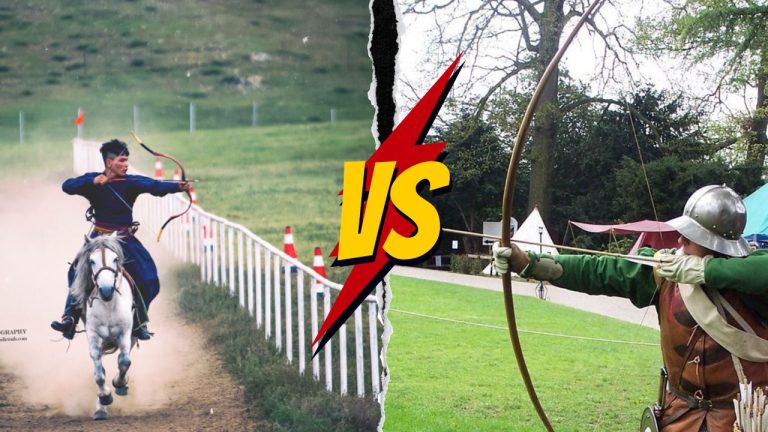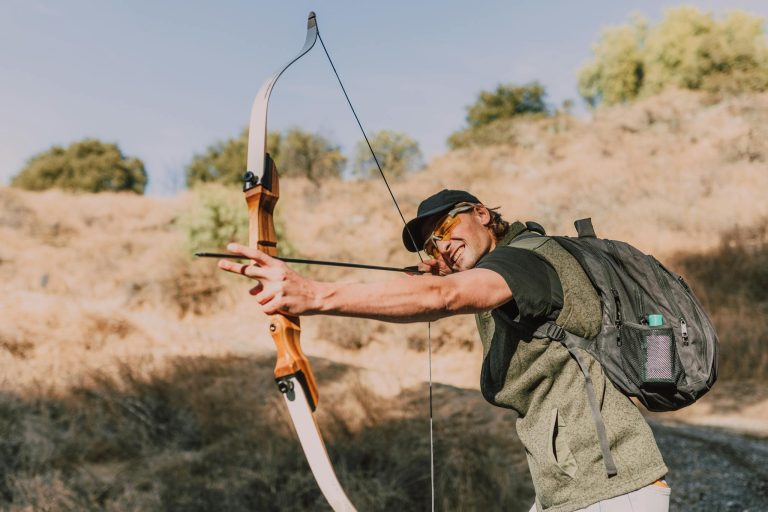Many archers are often torn between the choice of a recurve bow or a longbow. The decision is highly subjective, with each bow type offering distinct advantages. I’ll delve into the unique features and benefits of recurve bows and longbows. We’ll compare their pros and cons, suitability for different archery styles, and help you find which could be more beneficial for your needs.
Key Takeaways:
- The choice between a recurve bow and a longbow ultimately depends on individual preferences and shooting style.
- Recurve bows have curved limbs, while longbows have straight limbs
- Longbows are generally more forgiving and easier to shoot, while recurve bows offer versatility and adjustability.
- Choose the bow that feels most comfortable, suits your shooting goals, and brings you the most enjoyment in your archery journey.
Main Differences Between Recurve Bow vs Longbow
Choosing between a recurve bow and a longbow requires understanding their key differences. The primary contrast is in their shape and limb design. This affects their performance and shooting experience greatly.
Limb Design

A recurve bow features limbs that curve away, creating a “recurve” shape. This unique design boosts energy storage, enhancing arrow speed and power. In contrast, a longbow sports straight limbs, giving it a classic look. This simplicity helps in a smooth archery process, making it popular among purists.
Size and Length

Recurve bows are typically shorter and more maneuverable than longbows. Their compact size aids in aiming accuracy, especially in tight spaces. Conversely, longbows are longer, with a more extended draw length. This provides a smooth draw and forgives poor shooting posture more.
The bow’s shape, limb design, and size, along with their materials and construction, impact how they perform. These elements determine the unique shooting experiences each bow offers.
| Recurve Bow | Longbow | |
|---|---|---|
| Shape | Limbs curve away from the archer | Straight limbs throughout the bow’s length |
| Limb Design | Allows for more energy storage and greater speed and power | Provides a smooth and fluid shooting experience |
| Size | Shorter and more compact | Longer and often has a more extended draw length |
| Maneuverability | Easier to maneuver | Provides a smoother and steadier draw |
Grasping these differences equips you to wisely choose between a recurve bow or a longbow.
Pros and Cons of Longbow
The longbow stands out with its deep historical roots and classic allure. Yet, it has its own set of perks and downsides. It’s crucial to weigh the pros and cons of adopting a longbow. This examination will guide your decision-making, reflecting your archery tastes and aims.
Pros of Longbow
Many are drawn to the longbow owing to its tradition-rich features. Some benefits of opting for this bow type include:
- Forgiving and Easier to Shoot
- Higher Draw Weight and Stopping Power
- Heavier Arrows
Cons of Longbow
However, every coin has a flip side, and the longbow is no exception.
- Lower Arrow Speed
- Longer Length and Larger Size
- Not as portable
Pros and Cons of Recurve Bow
The recurve bow enjoys wide popularity due to its versatile nature. It is perfect for various archery types like target shooting, field archery, and bowhunting. Its compact design enhances handling in different environments, fitting for both practice ranges and the wild.
Pros of Recurve Bow
- Adjustable and versatile
- Portable & lighter arrows
- Affordable
Cons of Recurve Bow
However, the recurve bow is not without its challenges.
- Not as durable
- Low stopping power
Deciding on a recurve bow should be based on your archery goals and skill level.
Which is Better? Longbow vs Recurve Bow
Costs & Pricing
Determining the best bow for you involves looking at costs and pricing. Longbows and recurve bows vary in price due to brand, materials, craftsmanship, and features. Entry-level bows for both types are typically more affordable. However, custom bows may cost more. When deciding, think about your budget and your quality or customization needs.
Generally recurve bows are much cheaper because of how popular and widely it is used.
Power and Penetration
When it comes to power and penetration, both longbows and recurve bows have their strengths. Longbows, with their long draw length, deliver powerful, deep shots. Recurve bows, featuring modern designs, also hit hard. The power and penetration you get depend on the bow’s draw weight, the arrows, and your technique.
However, longbows generally have more power and penetration.
Shooting Distance
The bow’s design, the archer’s skill, and the type of archery affect shooting distance. Recurves are praised for their accuracy and range over longbows. Their recurve design and lighter arrow size for good long-distance shooting ranging 200m+ whereas longbows usually shoot around 100-150m range. Proper skill and practice can, however, extend the range of both types of bows.
Maintenance and Upkeep
The care needed for longbows and recurve bows differs. Longbows might need less work due to their simple, traditional build. Yet, checking for wood damage regularly is key. Maintenance for recurve bows focuses on string care, limb alignment, and other complex parts. Proper upkeep for both is vital for performance and longevity.
Suitability For The Types of Archery
| Type of Archery | Longbow Suitability | Recurve Bow Suitability |
|---|---|---|
| Target Archery | Less suitable | Highly suitable |
| Field Archery | Suitable | Suitable |
| Bowhunting | Suitable for close-range | Suitable for longer distances |
| Traditional Archery | Highly suitable | Less suitable |
The choice of bow, be it longbow or recurve, varies based on your archery focus. Each type, including target archery, field archery, bowhunting, and traditional archery, has its own needs. These needs affect your performance and competitive edge.
Longbows stand out in traditional archery, enhancing the challenge and authenticity. Their design aligns with an archaic history while demanding precise form and shot. This element makes them pivotal in traditional archery tournaments.
Recurve bows, on the other hand, are known for their adaptability. They meet the demands of target archery, where shooting accuracy is paramount. Their excellence extends to field and 3D archery. Here, their maneuverable design proves invaluable.
In bowhunting, longbows and recurves find their individual utilities. Longbows excel in close encounters, offering simplicity and natural shooting. For those keen on tradition and a close-shot approach, they are the bow of choice.
Final Thoughts | Which To Buy?

Choosing between a longbow and a recurve bow comes down to personal choice and the intended use. You should consider several factors before making your choice.
If you’re a beginner or want versatility, then choose a recurve.
Traditional archers often prefer longbows for authenticity and straightforward shooting.
Also, think about the budget and upkeep. The cost of these bows can differ based on brand and materials. The maintenance they require may also be a factor in your decision.
The ideal bow is one that not only feels right but also helps achieve your archery goals. It should bring you joy and satisfaction in your archery journey. Testing out various options, considering your needs and preferences, will ensure you make the best choice.





